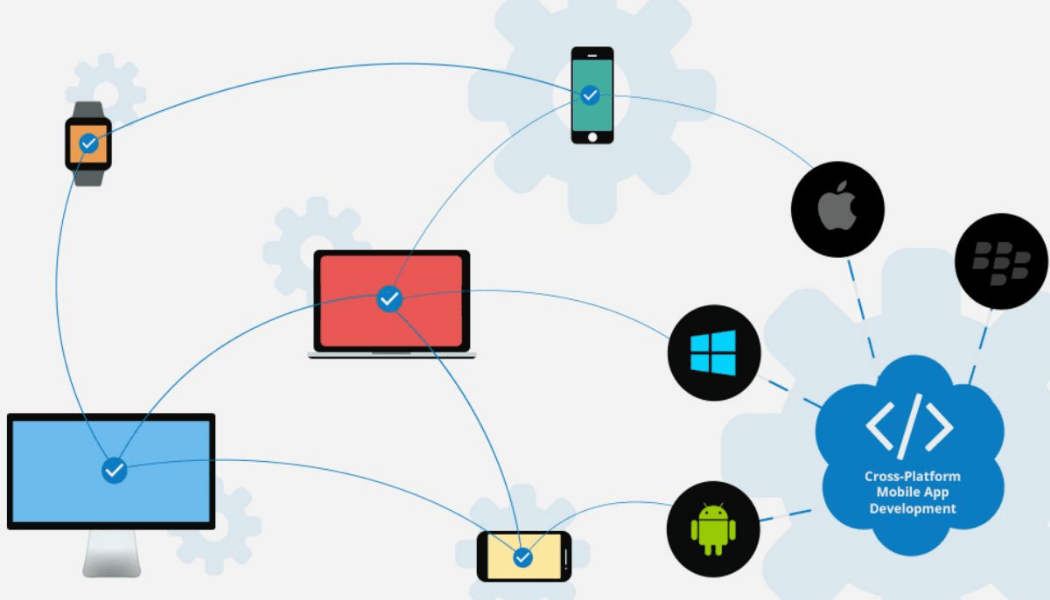Native/Cross-Platform Development:What's
Right for Your Project
Published on 27 September 2023

We might wish for a single technology that could create high-quality applications inexpensively and quickly, but such a panacea doesn't exist. However, there's no need for despair. The mobile development market offers solutions that cater to the specific needs and resources of each business. All you need to do is understand the advantages and disadvantages of these technologies and select the one that can save your budget and time while helping you realize a product aligned with your goals.
Native vs. Cross-Platform Development - Understanding the Differences
What is native and cross-platform development? It's an approach, a technology, a framework, and you can refer to it in various ways. However, it's incorrect to pit them against each other as direct competitors. You can develop one cross-platform application that's responsive and fast, while another may only excel when it's native.
How Native Apps Are Built
Native apps are constructed using programming languages native to the iOS and Android platforms:
As a result, native applications:
· Maximize performance.
· Have access to all smartphone services.
· Replicate the characteristic interface elements, gestures, animations, and functionality of the system.
Native apps are developed on both platforms to reach the widest possible audience, regardless of the type of smartphones people use. If budget constraints are a concern, launching the app first on one platform and later on the other is an option. However, concurrent development of iOS and Android versions is cost-effective, a choice often made by our clients. In this scenario, at least two developers collaborate on the application, one dedicated to iOS and the other to Android.
How Cross-Platform Applications Are Created
In contrast to native apps, cross-platform products are built on a shared code base. This shared code allows cross-platform apps to function on iPhones and other smartphones.
Cross-platform apps might seem like a magic solution, involving just one developer and a single app that costs half as much. However, the reality is a bit more nuanced.
Most cross-platform applications are hybrid apps that blend cross-platform technologies with native code to enable the application to integrate seamlessly with the platform. The complexity and functionality of the app determine the extent of native code required.
Developing a cross-platform app requires a full-stack developer, someone proficient in multiple programming languages. According to the Lucky Hunter agency, full-stack developers rank third in the list of the most sought-after IT professions. These professionals can be hard to find on the job market. As a result, companies often hire native developers, which can increase the cost of cross-platform development.
Popular Cross-Platform Technologies for Building Applications
Throughout this discussion, we'll frequently use the term "framework." To avoid any confusion, let's clarify it upfront.
If you're not an IT expert, you might have come across this term in the context of team workflow organization or work-life balance. To plan and adhere to a structured approach means to operate within a framework.
In development, it's quite similar. We're referring to a "framework" where code, not routines, fits in.
Xamarin
- What it is: A platform for iOS, Android, and Windows app development.
- Main programming language: C#
- Year of release: 2011
What's Good: Xamarin's architecture allows code reuse across different screens, making app development akin to constructing a puzzle. It genuinely saves developers time, though there can be variations in time required for different aspects.
Complexities: In Xamarin, only around 60% of the code is common to iOS and Android. Both platforms necessitate multi-stage, complex compilation into native code. Furthermore, each platform demands its own UI layer implementation. This can extend development timelines and costs.
Popularity Level: Bronze
2. React Native
- What it is: A framework for developing cross-platform applications developed by Facebook.
- Main programming language: JavaScript
- Year of release: 2015
What's Good: React Native involves native code and a container linked to a web application through a "bridge" (JS Bridge technology). The framework is versatile, suitable for developing web and iOS as well as Android apps. React Native's source code is open source, and a wealth of JavaScript libraries and frameworks are freely available.
Complexities: Developers must possess skills for both platforms to establish a bridge that connects with native elements, ensuring the app looks and functions natively. This approach results in a more intricate codebase and may have some performance drawbacks compared to other frameworks.
Popularity Level: Silver
3. Flutter
What it is: A framework from Google
Main programming language: Dart
Year of release: 2017
What's Good: Flutter is essentially an all-in-one toolkit, featuring tools, libraries, and documentation for application development. Unlike React Native, it doesn't require a bridge. Flutter employs its own widgets, which can partially replace platform-specific elements. This flexibility simplifies project implementation and maintenance, leading to cost savings.
Complexities: As of now, Flutter is still gaining traction. The Dart programming language is unfamiliar to Android, iOS, or web developers, making the learning curve steeper. A higher learning curve often correlates with increased costs.
Popularity Level: Gold
Presently, Flutter stands as the youngest and most prominent technology for cross-platform app development. It is considered the primary competitor to native development. To truly grasp where this framework excels and where it falls short, a deeper exploration is necessary.
Fast and Economical Cross-Platform App Development with Flutter: Fact or Fiction?
Flutter indeed offers a compelling option for cross-platform development, but it's not a one-size-fits-all solution for every project. Taking a realistic look at the technology reveals both its advantages and disadvantages.
Pros of Flutter Development
· Development with Flutter can be 15-20% more cost-effective than native development, particularly for single-function applications and MVP versions.
· Flutter boasts high performance compared to other cross-platform frameworks.
· Uniform interfaces across devices enable divergence from guidelines, achieve consistent design, and reduce development time.
Cons of Development on Flutter
· Not all platform features are supported; certain system functionalities (such as gestures and interface features) cannot be implemented in Flutter, and the UI design of applications may resemble that of websites.
· Some Flutter libraries may not work reliably, requiring developers to either build components from scratch (incurring additional costs) or use third-party libraries with the hope that they won't introduce critical bugs.
· For the implementation of complex or moderately complex functionalities in a cross-platform application, native developers may be necessary.
· Maintenance can be challenging as some issues are addressed with "workarounds" or code layers that simplify specific solutions but complicate the overall system. If a developer who was involved in the project unexpectedly departs, it could pose risks.
· Cross-platform applications tend to have larger codebases since one application combines code for two platforms, resulting in increased overall volume.
Pros and Cons of Native Development
Concerning the disadvantages of native development, the professional community generally agrees that it can be costly and time-consuming. After discussing the drawbacks, the conversation typically shifts to the benefits, as there are generally fewer downsides.
Disadvantages
· Separate versions must be developed for each platform, often requiring at least two developers for your project (iOS and Android). However, this doesn't necessarily translate into native development being more expensive than implementing equivalent functionality using a cross-platform framework.
· Native app development often extends over a timeframe of three months or more, making it less suited to "should-have-been-done-yesterday" deadlines. Native development is meticulous, with developers rigorously testing the application in various scenarios to minimize bugs and ensure it enhances business KPIs.
Advantages
· Native applications can fully leverage all platform features since they have access to the entire operating system's capabilities. As a result, users find these apps familiar, with predictable, understandable, and safe interactions.
· Native technologies are capable of implementing functionalities of any complexity, making them suitable for a wide range of business needs.
· Native apps allow for custom designs and unique animations, enabling tailored appearances that align with the interests and preferences of the target audience.
· Native apps are highly responsive and deliver minimal waiting times to users. This positive experience positively influences user attitudes and return metrics.
· Native development benefits from a proficient mobile development team that can handle complex projects effectively.
Choosing Between a Native App or a Cross-Platform App for Your Business
Not every business can afford a native app, nor does every business necessarily require one. The choice depends on your specific goals and scope. By analyzing which types of businesses opt for native apps and which lean toward cross-platform frameworks, certain patterns emerge.
Projects Suitable for Flutter Development
- MVP Versions: Flutter is suitable for developing Minimum Viable Product (MVP) versions of applications. It's an excellent choice for testing hypotheses and launching your product in the business world. If you receive a positive response from the audience and plan to scale the project, consider transitioning to native technology.
- Mono-functional Applications: Projects with a single primary function can be effectively implemented using Flutter. Its performance is sufficient to execute such applications quickly and responsively.
- Non-commercial Projects: Cross-platform applications developed with Flutter offer a fast time-to-market, making them advantageous for non-commercial projects without monetization goals. From a business perspective, non-commercial ventures not focused on revenue generation are more cost-effective when built on Flutter.
Projects Requiring Native Technologies
- Medium and Large Business Projects: Native applications are well-suited for medium and large businesses. They are predictable, scalable, and backed by support from Google and Apple. Corporations do not discontinue support for their platform languages. If you seek long-term and reliable mobile business development, native development is the preferred choice.
- Projects with Complex Functionality: To create a memorable application that can compete in the market, especially when incorporating complex technologies and standout features, native development is essential. Cross-platform solutions currently lack support for advanced tools like AR/VR, 3D modeling, video chats, and gamification.
- Superapps: Native applications are ideal for superapps that require extensive integrations, diverse functionalities, and support for various user roles.
If an application performs slowly, users may not have the patience to appreciate it. In such cases, the efforts and resources invested in development may not yield a profitable product. To prevent this outcome, choose a technology aligned with your project's goals and objectives.
Selecting a Development Team
We have provided a brief overview of both cross-platform and native development approaches, allowing you to draw your own conclusions. If you find it challenging to select the right technology, feel free to reach out to us. We can discuss your project and help you determine the best approach.
If you've already made a decision about the technology for your project, please get in touch with us. The most critical aspect of development is assembling a skilled team, and we are here to assist you in creating an app that aligns with your business's needs and goals.
Recommended Tutorials
Stay updated with our latest articles, industry insights, and expert tips to keep your business informed and inspired.

We Anticipate Risks and Offer Simple Solutions.Software development encompasses...
Learn More
This in-depth analysis of BrowseFragment's capabilities for Android TV developme...
Learn More